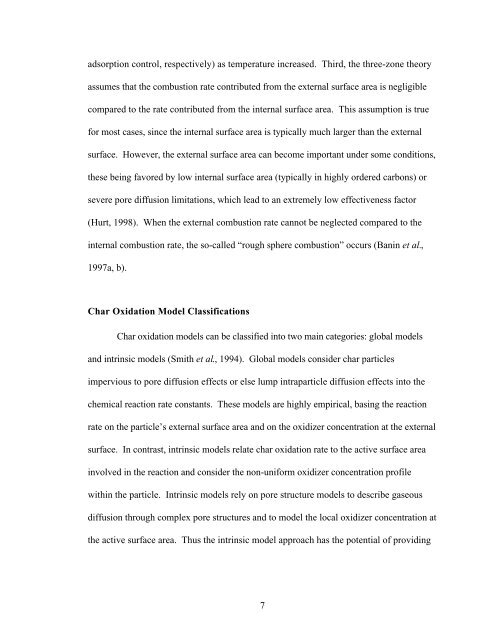MODELING CHAR OXIDATION AS A FUNCTION OF PRESSURE ...
MODELING CHAR OXIDATION AS A FUNCTION OF PRESSURE ...
MODELING CHAR OXIDATION AS A FUNCTION OF PRESSURE ...
You also want an ePaper? Increase the reach of your titles
YUMPU automatically turns print PDFs into web optimized ePapers that Google loves.
adsorption control, respectively) as temperature increased. Third, the three-zone theory<br />
assumes that the combustion rate contributed from the external surface area is negligible<br />
compared to the rate contributed from the internal surface area. This assumption is true<br />
for most cases, since the internal surface area is typically much larger than the external<br />
surface. However, the external surface area can become important under some conditions,<br />
these being favored by low internal surface area (typically in highly ordered carbons) or<br />
severe pore diffusion limitations, which lead to an extremely low effectiveness factor<br />
(Hurt, 1998). When the external combustion rate cannot be neglected compared to the<br />
internal combustion rate, the so-called “rough sphere combustion” occurs (Banin et al.,<br />
1997a, b).<br />
Char Oxidation Model Classifications<br />
Char oxidation models can be classified into two main categories: global models<br />
and intrinsic models (Smith et al., 1994). Global models consider char particles<br />
impervious to pore diffusion effects or else lump intraparticle diffusion effects into the<br />
chemical reaction rate constants. These models are highly empirical, basing the reaction<br />
rate on the particle’s external surface area and on the oxidizer concentration at the external<br />
surface. In contrast, intrinsic models relate char oxidation rate to the active surface area<br />
involved in the reaction and consider the non-uniform oxidizer concentration profile<br />
within the particle. Intrinsic models rely on pore structure models to describe gaseous<br />
diffusion through complex pore structures and to model the local oxidizer concentration at<br />
the active surface area. Thus the intrinsic model approach has the potential of providing<br />
7
















